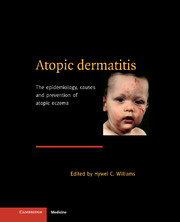Book contents
- Frontmatter
- Contents
- List of contributors
- Foreword Georg Rajka
- Preface
- Part I The nature of the problem
- Part II Descriptive studies which indicate the size of the problem
- Part III Analytical studies which point to causes of atopic dermatitis
- 8 Genetic epidemiology of atopic dermatitis
- 9 Fetal and perinatal origins of atopic dermatitis
- 10 Social factors and atopic dermatitis
- 11 The ‘old mother’ hypothesis
- 12 The possible role of environmental pollution in the development of atopic dermatitis
- 13 Atopic dermatitis in migrant populations
- 14 The role of inhalant allergens in atopic dermatitis
- 15 Dietary factors in established atopic dermatitis
- Part IV Intervention studies
- Part V Lessons from other fields of research
- Part VI Conclusions
- Additional information
- Index
- Plate section
9 - Fetal and perinatal origins of atopic dermatitis
from Part III - Analytical studies which point to causes of atopic dermatitis
Published online by Cambridge University Press: 17 August 2009
- Frontmatter
- Contents
- List of contributors
- Foreword Georg Rajka
- Preface
- Part I The nature of the problem
- Part II Descriptive studies which indicate the size of the problem
- Part III Analytical studies which point to causes of atopic dermatitis
- 8 Genetic epidemiology of atopic dermatitis
- 9 Fetal and perinatal origins of atopic dermatitis
- 10 Social factors and atopic dermatitis
- 11 The ‘old mother’ hypothesis
- 12 The possible role of environmental pollution in the development of atopic dermatitis
- 13 Atopic dermatitis in migrant populations
- 14 The role of inhalant allergens in atopic dermatitis
- 15 Dietary factors in established atopic dermatitis
- Part IV Intervention studies
- Part V Lessons from other fields of research
- Part VI Conclusions
- Additional information
- Index
- Plate section
Summary
Introduction
We have become accustomed to the idea that many disorders of adult life such as noninsulin-dependent diabetes, hypertension and obstructive airways disease arise through an interaction between a genetically determined susceptibility and influences in the current environment including diet, obesity, smoking and allergen exposure. Recent research, however, suggests that the fetal and early infant environment may play a critical role in programming a lifelong predisposition to a number of common adult diseases. As yet, there is only limited and indirect evidence to suggest major long-term effects of the fetal and perinatal environment in relation to atopic dermatitis (AD). Research into this hypothesis, however, is in its very earliest stages and future epidemiological studies of the fetal environment may provide important insights into the aetiology of AD.
The concept of programming during early development
In fetal life and early infancy different tissues of the body grow during periods of rapid cell division, so-called ‘critical’ periods (Widdowson & McCance, 1975). The timing of these critical periods differs for different tissues; a critical period for reproductive tract development exists, for example, very early in development (Beral & Colwell, 1981), as compared with one for kidney development later in gestation between 26 and 34 weeks of pregnancy (Konje et al., 1996). Growth depends on nutrients and oxygen, and the fetus's main adaptation to the lack of these is to slow its rate of cell division, especially in those tissues which are undergoing critical periods at the time.
- Type
- Chapter
- Information
- Atopic DermatitisThe Epidemiology, Causes and Prevention of Atopic Eczema, pp. 125 - 138Publisher: Cambridge University PressPrint publication year: 2000
- 5
- Cited by



